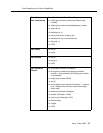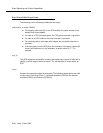
Event Reporting and U-Abort Capabilities
Issue 7 May 1998
3-9
Alerting Event Report
ECS sends the Alerting Event Report for monitored, controlled, and
domain-controlled calls when the following events occur:
■ When the destination of a call is an on-ECS station and ringing or zip tone
is started.
■ When a call is redirected to an off-ECS station and the ISDN ALERTing
message is received from an ISDN-PRI facility.
■ When a switch-classified call is trying to reach an off-ECS station, and the
call classifier detects either precise, imprecise, or special ringing.
■ When a switch-classified or user-classified call is placed to an off-ECS
station, and the ALERTing message is received from the ISDN-PRI facility.
NOTE:
When a classifier and an ISDN-PRI facility both report alerting on a
switch-classified call, then the first occurrence generates an Alerting
Event Report; succeeding reports are not reported by ECS.
Consecutive Alerting Event Reports are possible in the following cases:
■ A station is alerted first and the call goes to coverage; an Alerting Event
Report is generated each time a new station is alerted.
■ A principal and its bridging users are alerted; an Alerting Event Report is
generated for the principal and for each bridged station alerted.
■ A call is alerting a Terminating Extension Group (TEG); one report is sent
for each TEG member alerted.
■ A call is alerting a Personal Central Office Line (PCOL); tone report is sent
for each PCOL member alerted.
■ A call is alerting a coverage/answer point; one report is sent for each
alerting member of the coverage answer group.
■ A call is alerting a principal with SAC active; one report is sent for the
principal and one or more are sent for the coverage points.
The Alerting Event Report is
not sent
for calls that connect to announcements as
a result of ACD split forced announcement or announcement vector commands.
When an ASAI-monitored call reaches a converse vector step, the ALERTing
message sent to the ASAI host will include an optional cause (CS3/23) to inform
the ASAI host that the call has been routed, using the converse vector step.


















